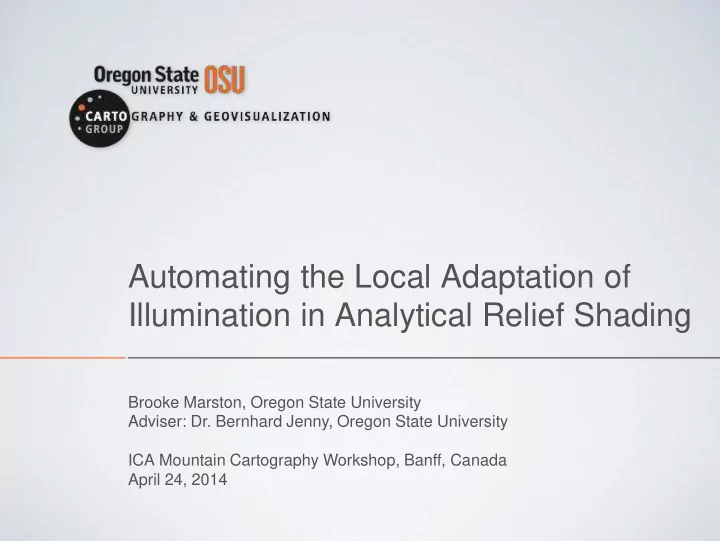

Automating the Local Adaptation of Illumination in Analytical Relief Shading Brooke Marston, Oregon State University Adviser: Dr. Bernhard Jenny, Oregon State University ICA Mountain Cartography Workshop, Banff, Canada April 24, 2014
Relief Shading Analytical Manual Source: reliefshading.com
Current Analytical Relief Shading Lambertian R eflect ion Algorithm l = direction of illumination n = normal vector Pixel gray value = 255 × cos( α ) Source: B. Marston
Why is manual preferred? • Locally bright and dark slopes improve legibility and aesthetic quality • E asier and faster for the user to interpret topography Matterhorn Matterhorn Source: reliefshading.com (left) Google Maps (right)
Why is manual preferred? • Better for small-scale maps where contours degenerate Source: reliefshading.com
Why aren ’ t there more manually shaded relief maps? • E xpense of present manual methods of production • Time-intensive • Requires skilled artists with good insight into cartography Source: reliefshading.com
Diffusion Curves
Diffusion Curves • Developed by Orzan et al. (2008) • Vector-based primitive for creating smooth-shaded images • Curve that diffuses colors on both sides of the space it divides Source: Orzan et al. “ Diffusion Curves: A Vector Representation for Smooth-Shaded Images. ” ACM T ransactions on Graphics (Proceedings of SIGGRAPH 2008) , 27(2008): 1 – 8.
Diffusion Curves E. Imhof manual relief shading Reproduction using Diffusion Curves Source: library .ethz.ch (left), B. Marston (right)
ridgelines valleylines shaded relief Source: B. Marston
Maximum Branch Length The longest branch length between a grid cell's fl owpath and the fl owpaths initiated at each of its neighbors Source: Lindsay , John B. and J a n Seibert. “ M easuring the significan ce of a divide to local drainage patterns. ” International Journal of Geographical Information Science 27, no. 7 (2013): 1453 – 1468 (image, left); B. Marston (image, right)
Flow Accumulation Source: B. Marston
Vectorizing Lines
1. Grayscale 2. Binary 3. Skeletonized 4. Branch Points
Branch Points Shapefile
In itial Output Source: B. Marston
Adjusting Illumination
Deviation of illumination angle Illumination - aspect
Deviation of illumination angle Illumination - aspect
Deviation of illumination angle Illumination - aspect
Douglas-Peucker Simplification for Adjusting the Variability of Illumination
Aspect for Adjusting the Illumination Direction Low tolerance High tolerance Original
Before After
Diffusion Curves Shading
Graphical User Interface
Results
Analytical Marston & Jenny Source: B. Marston & B. Jenny
Manual Marston & Jenny Source: reliefshading.com (left), B. Marston & B. Jenny (right)
Future Work • Improve valley floor extraction Source: B. Marston
Future Work • Network analysis • Adjust illu mination and detail according to scale • In corporate hypsometric tinting
Acknowledgments • Dr. Bernhard Jen ny, Oregon State University • Tom Patterson, National Park Service • Johannes Liem, Oregon State University • ICA Commission on Mountain Cartography • AAG Cartography Specialty Group • Phi Beta K appa
Thank you Questions?
References • Brassel, K urt. “ A Model for Automatic Hill-Shading. ” The American Cartographer 1, no. 1 (1974): 15 – 27. • Horn, Berthold K . P. “H ill Shading and the R eflect ance Map. ” Proceedings of the IEEE 49, no. 1 (1981):14 – 47. duard. Cartographic Relief Representation . E • Imhof, E dited By H.J . Steward. Redlands: E SRI, 2007. • Je nny, Bernhard. “ An In teractive Approach to Analytical Relief Shading. ” Cartographica 38, no. 1 & 2 (2001): 67 – 75. • Jeschke, Stefan, David Cline, and Peter Wonka. “ A GPU Laplacian Solver for Diffusion Curves and Poisson Image E diting. ” Transaction on Graphics (Siggraph Asia 2009) , 28, no. 5 (2009): 1 – 8. • K atzil, Yaron and Yearch Doytsher. “ A logarithmic and sub-pixel approach to shaded relief representation. ” Computers & Geosciences 29 (2003): 1137 – 1142. • K ennelly, Patrick J . “ Terrain maps displaying hill-shading with curvature. ” Geomorphology 102 (2008): 567 – 577.
References • K ennelly, Patrick J . and A. J a mes Stewart. “ a Uniform Sky Illumination Model to E nhance Shading of Terrain and Urban Areas. ” Cartography and Geographic Information Science 33, no. 1 (2006): 21 – 36. • Leonowicz, Anna, Bernhard Je nny, and Lorenz Hurni. “ Automated Reduction of Visual Complexity in Small-Scale Relief Shading. ” Cartographica 45, no. 1 (2010): 64 – 74. • Lindsay, John B. and J a n Seibert. “ Measuring the sign ifica nce of a divide to local drainage patterns. ” International Journal of Geographical Information Science 27, no. 7 (2013): 1453 – 1468. • Orzan et al. “ Diffusion Curves: A Vector Representation for Smooth-Shaded Images. ” ACM Transactions on Graphics (Proceedings of SIGGRAPH 2008) , 27(2008): 1 – 8. nhancement. ” The • Podobnikar, Tomaz. “ Mutlidirectional Visibility In dex for Analytical Shading E Cartographic Journal 49, no. 3 (2012): 195 – 207. • Rusinkiewicz, Szymon, Michael Burns, and Doug DeCarlo. “ E xaggerated Shading for Depicting Shape and Detail. ” ACM Transactions on Graphics 25, no. 3 (2006): 1199 – 1205.
Recommend
More recommend